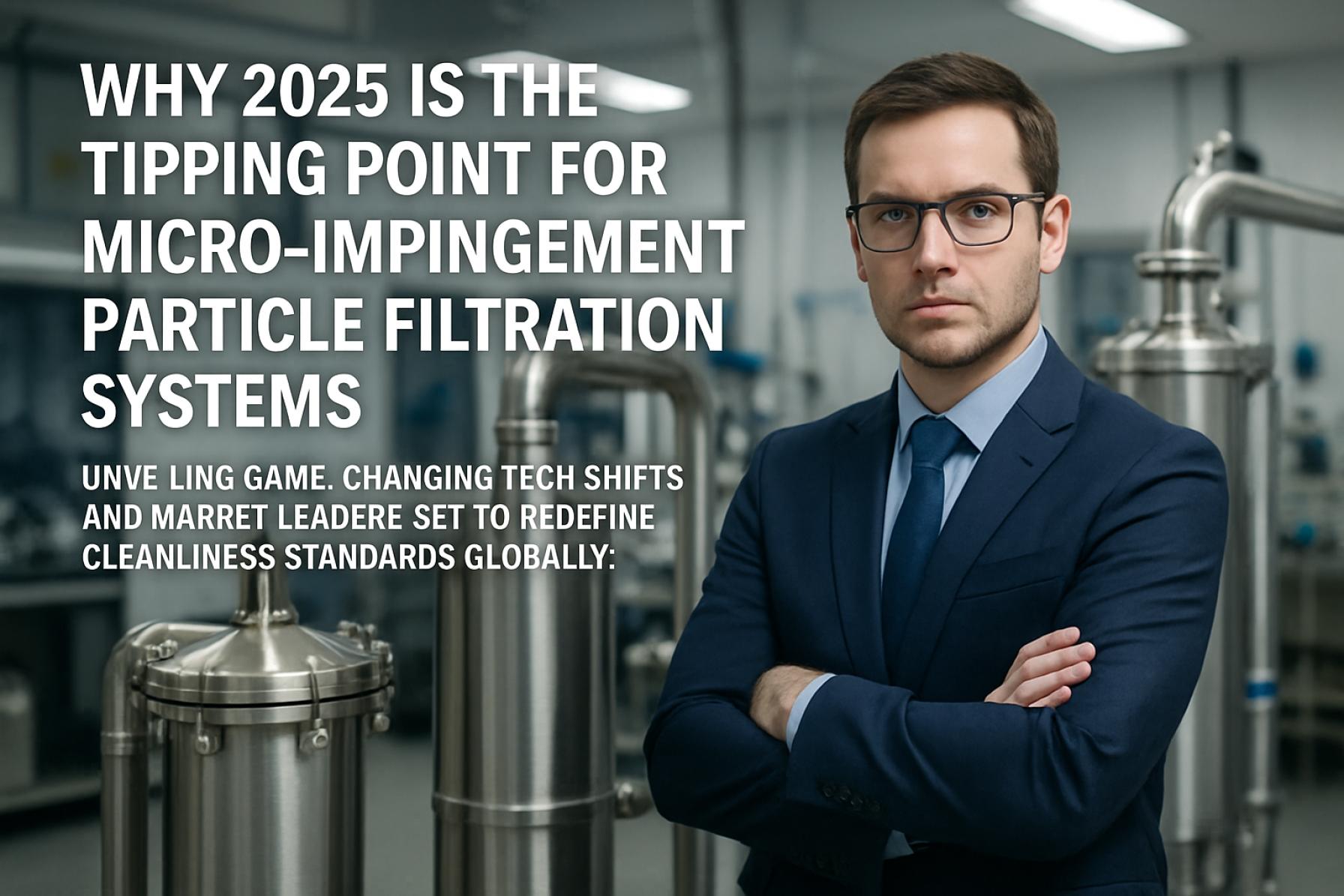Micro-Impingement Filtration: 2025 Breakthroughs Set to Disrupt Air & Water Purity Markets
Table of Contents
- Executive Summary: Micro-Impingement Filtration Market at a Glance (2025-2030)
- Technology Overview: How Micro-Impingement Filtration Systems Work
- Key Manufacturers and Industry Bodies (2025) – Company Innovations and Official Initiatives
- Market Size and Growth Forecast Through 2030
- Emerging Applications Across Air, Water, and Industrial Sectors
- Driving Forces: Regulatory Trends and Sustainability Demands
- Competitive Landscape: Strategy Shifts by Leading Suppliers
- R&D and Patent Activity: Tracking Next-Gen Filtration Breakthroughs
- Opportunities and Challenges: Supply Chain, Cost, and Adoption Barriers
- Future Outlook: What the Next Five Years Hold for Micro-Impingement Filtration
- Sources & References
Executive Summary: Micro-Impingement Filtration Market at a Glance (2025-2030)
Micro-impingement particle filtration systems are emerging as a key technology in advanced air and liquid filtration, targeting sectors with stringent particulate control requirements such as pharmaceuticals, microelectronics, food & beverage, and healthcare. In 2025, the market is experiencing accelerated innovation and adoption, driven by regulatory pressure for cleaner environments, growing awareness of indoor air quality, and increasing demand for high-purity manufacturing processes.
Leading companies are reporting significant investments in R&D to enhance the efficiency and scalability of micro-impingement mechanisms. For instance, Donaldson Company, Inc. is advancing their proprietary micro-impingement media, focusing on reducing pressure drop while maintaining high capture rates for submicron particles. Likewise, Pall Corporation has expanded its product lines with next-generation micro-impingement filters for semiconductor and bioprocessing applications, addressing the increasing standards for contamination control.
Recent installations in critical infrastructure, such as hospital ventilation systems and data centers, demonstrate the scalability and adaptability of micro-impingement systems. Camfil has highlighted their collaborations with healthcare providers in North America and Europe to deploy micro-impingement air handling solutions that meet or exceed ISO 16890 and EN 1822 standards. Meanwhile, MANN+HUMMEL continues to support automotive and industrial clients with filtration systems tailored for ultra-fine particulate control, which is increasingly required for electric vehicle battery production and cleanroom manufacturing.
Looking ahead to 2030, the outlook for micro-impingement particle filtration systems is robust. The sector is expected to benefit from ongoing advances in filter media design, digital monitoring integration, and modular system architectures. Industry players are also collaborating with standards organizations to help shape upcoming regulatory frameworks, ensuring that micro-impingement solutions remain compliant and competitive. The rise of smart filtration—where filter performance and maintenance are monitored in real-time—will further drive adoption across industries seeking to reduce operational costs and guarantee regulatory compliance.
Overall, from 2025 onwards, the micro-impingement filtration market is positioned for sustained growth, underpinned by technological advancements, cross-industry collaborations, and a global focus on health, safety, and process reliability.
Technology Overview: How Micro-Impingement Filtration Systems Work
Micro-impingement particle filtration systems represent a significant advance in air and fluid purification technology, employing a unique mechanical approach to capture fine particulates. At the core of these systems is the principle of impingement: contaminated air or liquid is forced at high velocity through a matrix of micro-engineered obstacles, where inertia causes particles to deviate from the fluid streamlines and impact onto collection surfaces. Unlike traditional membrane or depth filters, micro-impingement systems leverage microscale features—such as precisely structured nozzles, vanes, or grids—to optimize particle collision, adhesion, and removal efficiency.
Recent developments have been driven by both the demand for higher filtration efficiency and the need to reduce energy consumption. In 2025, leading manufacturers are integrating advanced materials such as chemically treated stainless steel, high-grade polymers, and even nanostructured surfaces to enhance particle capture while minimizing pressure drop. For example, Pall Corporation has introduced micro-impingement modules for cleanroom and process industries that feature modular, cleanable elements with micron-scale impingement sites, allowing for both high retention rates and long service intervals.
The operational principle typically involves a turbulent or directed flow regime. As the process fluid or air passes through the impingement section, larger and mid-sized particles are separated by inertia, while submicron particles may be agglomerated on engineered surfaces. Some systems incorporate secondary electrostatic or surface energy enhancements to encourage finer particle adhesion, further improving removal rates without the need for denser filter media.
Commercial applications in the pharmaceutical, semiconductor, and food processing sectors are expanding as regulatory requirements for particulate and microbial control tighten. Trojan Technologies and Eaton are among the companies actively developing and marketing micro-impingement solutions for critical process streams, with systems capable of filtering down to the submicron range while maintaining high flow rates and low maintenance needs.
Looking forward, the next few years are likely to see further integration of digital monitoring and adaptive flow control within micro-impingement systems, enabling predictive maintenance and real-time optimization. Innovations in additive manufacturing and microfabrication are expected to yield even more intricate impingement geometries, pushing the limits of filtration efficiency for emerging contaminants and ultra-fine particles. With sustainability also a key driver, manufacturers are increasingly focused on reusability, clean-in-place (CIP) capabilities, and energy-efficient operation as standard features for next-generation micro-impingement filtration platforms.
Key Manufacturers and Industry Bodies (2025) – Company Innovations and Official Initiatives
In 2025, the landscape of micro-impingement particle filtration systems is being shaped by a cohort of leading manufacturers and industry bodies investing in advanced filtration technologies and sustainability initiatives. Notable among these are companies leveraging novel micro-impingement techniques to enhance the separation of fine particulates in industries ranging from pharmaceuticals to electronics manufacturing.
One of the industry leaders, Pall Corporation, continues to expand its range of high-efficiency micro-impingement filtration products, emphasizing both performance and adaptability for demanding environments. In 2025, Pall is focusing on integrating real-time monitoring systems with its filtration units, allowing for predictive maintenance and reduced downtime. This digital approach aims to deliver up to 20% increased operational efficiency, based on internal field trials.
Similarly, Parker Hannifin is rolling out next-generation micro-impingement filtration modules targeting ultrafine particle removal in cleanroom and semiconductor applications. Their 2025 product lineup features modularity, allowing end-users to customize filter configurations, which is especially important as chip manufacturing tolerances become even tighter.
On the regulatory and standards front, the International Organization for Standardization (ISO) continues to update and refine standards for particle filtration in critical applications. In 2025, ISO committees are expected to publish new guidelines specific to micro-impingement systems, focusing on test protocols for sub-micron particle capture and system validation.
Another key player, Donaldson Company, Inc., is expanding its portfolio of cartridge filters with enhanced micro-impingement technology. In response to stricter workplace air quality regulations, Donaldson is collaborating with manufacturing partners to deploy pilot systems in high-dust environments and is reporting preliminary reductions of airborne particulates by up to 35%.
Industry bodies like the NAFEMS (National Agency for Finite Element Methods and Standards) are also supporting research into computational modeling of impingement flows, facilitating optimization of filter geometries. Their 2025 workshops and technical papers are expected to influence the next wave of product design and testing protocols.
Looking ahead, the sector is poised for accelerated innovation as manufacturers increasingly align with digitalization, regulatory harmonization, and sustainability targets. The ongoing collaboration between leading filtration companies and official industry bodies is set to drive the adoption of micro-impingement particle filtration across critical industries worldwide.
Market Size and Growth Forecast Through 2030
Micro-impingement particle filtration systems are gaining prominence across diverse industries—most notably in sectors such as pharmaceuticals, biotechnology, food and beverage, and microelectronics—due to their superior efficiency in trapping ultrafine particles and biological contaminants. As of 2025, the global market for advanced particle filtration technologies, including micro-impingement systems, is estimated to be valued in the several hundred million USD range, with key growth attributed to increasing regulatory standards for air quality and contamination control. The ongoing emphasis on indoor air quality in the wake of the COVID-19 pandemic has accelerated adoption rates in healthcare, cleanroom environments, and high-precision manufacturing.
Major industry players such as Camfil and Donaldson Company, Inc. are expanding their portfolios to include micro-impingement solutions, reflecting the sector’s strong growth trajectory. Camfil has reported increased demand for their high-efficiency filtration units in microelectronics and pharmaceutical manufacturing facilities, while Donaldson Company, Inc. continues to invest in R&D for next-generation impingement filter media, targeting applications that require submicron particle capture and high air throughput.
The Asia-Pacific region is projected to lead in market expansion through 2030, driven by rapid industrialization, tightening environmental regulations, and large-scale infrastructure projects in China, India, and Southeast Asia. European markets, guided by the European Union’s stringent clean air directives and the growth of the life sciences sector, are also expected to see robust growth. North America remains a strong contributor, especially in semiconductor fabrication and hospital infrastructure upgrades.
Looking ahead to 2030, the market for micro-impingement particle filtration systems is forecast to demonstrate a compound annual growth rate (CAGR) in the upper single digits, underpinned by ongoing investments in clean manufacturing, rising awareness of occupational health, and continued innovation in filter design. Advancements in nanofiber materials and smart filtration monitoring—such as those being developed by Camfil—are expected to further enhance system efficiency and adoption rates. Strategic collaborations between system manufacturers and end-user industries are likely to accelerate the deployment of custom-engineered solutions, ensuring continued expansion over the next several years.
Emerging Applications Across Air, Water, and Industrial Sectors
Micro-impingement particle filtration systems are demonstrating significant advancements and adoption across air, water, and industrial sectors as of 2025, driven by tightening regulatory requirements and increasing demand for high-efficiency contaminant removal. In the air filtration domain, these systems are being deployed in settings that require sub-micron particulate control, such as hospitals, semiconductor manufacturing, and cleanroom environments. Notably, Camfil has expanded its portfolio, integrating micro-impingement mechanisms within HEPA and ULPA filter lines to target airborne pathogens and ultrafine particulates, addressing global concerns over indoor air quality.
In the water sector, micro-impingement filtration is gaining traction for municipal and industrial water treatment. These systems are designed to capture particles smaller than those removed by conventional sand or media filters, making them valuable for pre-treatment in desalination plants and wastewater reuse. For example, Pall Corporation has reported increased adoption of its advanced micro-impingement modules for removing microplastics and biological contaminants in both potable and industrial water streams. The technology is also being incorporated into modular systems for decentralized water purification, aligning with the push towards distributed infrastructure.
Industrial applications are equally robust, particularly within the pharmaceutical, food and beverage, and chemical processing sectors. Here, micro-impingement systems enable precise filtration of process fluids, aiding in compliance with stringent product purity standards. Eaton has introduced new filter cartridges and housings optimized for micro-impingement, targeting applications such as high-purity water for electronics manufacturing and catalyst recovery in chemical synthesis. Furthermore, these systems are being engineered for high throughput and low energy consumption, supporting sustainability goals set by manufacturers.
Looking ahead, the sector is expected to witness rapid technological integration, with sensors and automated monitoring becoming standard for ensuring optimal filtration performance and predictive maintenance. Leading suppliers such as Donaldson Company, Inc. are investing in digitalization, enabling real-time data collection and remote management of filtration systems across multiple sites. Additionally, emerging materials—such as nanofiber meshes and advanced polymers—are anticipated to further enhance impingement efficiency and filter lifespan, meeting evolving regulatory and operational needs into the late 2020s.
Driving Forces: Regulatory Trends and Sustainability Demands
Micro-impingement particle filtration systems are experiencing rapid evolution in response to intensifying regulatory pressures and the global shift toward sustainability. By 2025, stringent air quality and emissions standards—especially in industrial and healthcare sectors—are shaping the technological trajectories and adoption rates of these advanced filtration solutions.
Regulatory bodies worldwide continue to enforce lower permissible particle emissions, compelling industries to integrate more efficient filtration systems. In the United States, the Environmental Protection Agency (EPA) has updated its National Ambient Air Quality Standards (NAAQS) to further restrict particulate matter (PM2.5 and PM10) emissions, prompting manufacturers to adopt advanced micro-impingement technologies for compliance (Environmental Protection Agency). Similarly, the European Union’s Industrial Emissions Directive (IED) and the tightening of air quality standards under the European Green Deal are accelerating investment in high-efficiency filtration across manufacturing, energy, and waste management sectors (European Commission).
The drive for sustainability is also a powerful catalyst. Customers and stakeholders increasingly demand that filtration systems not only deliver high capture efficiency but also minimize energy consumption and environmental impact. Micro-impingement systems have responded with innovations such as low-pressure-drop designs, extended filter lifespans, and recyclable filter media. For example, Donaldson Company, Inc. and Camfil have introduced next-generation impingement filters with enhanced particulate removal and energy-efficient operation, aligning with evolving sustainability benchmarks.
Global supply chain and energy considerations are also shaping the outlook for 2025 and beyond. The push for localized manufacturing and resilient supply chains is driving regional production of filtration components, reducing transportation emissions and supporting circular economy goals. At the same time, the adoption of digital monitoring and predictive maintenance—enabled by sensor integration in micro-impingement systems—is improving operational efficiency and regulatory compliance by providing real-time air quality data (Camfil).
Looking ahead, regulatory harmonization and sustainability incentives are expected to further accelerate the deployment of micro-impingement particle filtration systems across sectors that require ultra-fine particle control, such as pharmaceuticals, semiconductors, and food processing. Industry leaders are poised to capitalize on these trends by advancing system performance, lifecycle management, and eco-design, ensuring that filtration technologies remain at the forefront of environmental stewardship and regulatory compliance.
Competitive Landscape: Strategy Shifts by Leading Suppliers
The landscape for micro-impingement particle filtration systems is undergoing notable changes in 2025 as leading suppliers adapt to stricter regulatory demands, increased sustainability pressures, and the rising complexity of air and fluid purity requirements across industries. Key players are refining their strategies through targeted investments, product innovation, and strategic collaborations.
In 2025, Pall Corporation, a prominent filtration technology provider, has emphasized expansion in high-purity microelectronics and pharmaceutical manufacturing. The company has launched new micro-impingement filter modules designed for enhanced removal efficiency of sub-micron contaminants, responding to increased semiconductor process purity demands. Their strategy also includes digital integration, with smart filtration units equipped for real-time monitoring and predictive maintenance, aiming to minimize downtime and ensure compliance with evolving process standards.
Similarly, Parker Hannifin Corporation is leveraging its engineering expertise to diversify offerings in micro-impingement systems for industrial and life sciences applications. In 2025, Parker’s Filtration Group has advanced its modular design philosophy, enabling integration into existing process lines with minimal disruption. Their recent focus has been on reducing energy consumption and waste by optimizing impingement geometries and filter media, aligning with global sustainability goals and customer cost-reduction initiatives.
Another significant development is the entry of Donaldson Company, Inc. into compact micro-impingement solutions tailored for cleanroom and laboratory environments. In 2025, Donaldson has prioritized rapid prototyping and customization to address unique customer specifications, particularly in biotechnology and advanced materials sectors. Their competitive strategy involves leveraging global manufacturing capabilities to provide faster delivery and localized technical support.
Collaborative ventures are a defining trend, as evidenced by Camfil’s partnerships with university research centers to accelerate next-generation particle capture technologies. In 2025, Camfil’s strategy is to co-develop filtration solutions that target emerging contaminants in microelectronics and pharmaceutical production, with a particular emphasis on nanomaterial containment.
Looking forward, competition is expected to intensify as suppliers integrate IoT-enabled monitoring, sustainable materials, and adaptive system designs. These strategic shifts will likely drive greater market differentiation and foster solutions that respond proactively to the increasingly stringent purity and energy-efficiency requirements across critical industries.
R&D and Patent Activity: Tracking Next-Gen Filtration Breakthroughs
Micro-impingement particle filtration systems—technologies that capture airborne particulates through the forceful impingement of particles onto micro-structured surfaces—are experiencing a surge in research and patent activity as industries seek higher-efficiency solutions for air and process fluid purification. In 2025, R&D efforts are concentrated on enhancing the performance, scalability, and sustainability of these systems, with notable focus on their application in semiconductors, pharmaceuticals, cleanrooms, and industrial HVAC.
- R&D Initiatives and Collaborations: Leading filtration manufacturers are investing in advanced micro-impingement designs that minimize pressure drop while maximizing particle capture, including sub-micron aerosols and nanomaterials. Pall Corporation is actively developing new polymeric and metallic micro-structured media, aiming for enhanced sterilization and longer filter life. In parallel, Parker Hannifin Corporation is expanding its research into hybrid micro-impingement and electrostatic filtration, targeting the next generation of ISO Class 1 cleanroom requirements.
- Patent Activity: The past 18 months have seen a marked increase in patent filings for micro-impingement systems featuring novel geometries and self-cleaning capabilities. MANN+HUMMEL has filed patents for modular cartridge systems with integrated micro-impingement arrays, designed for rapid swap-out in high-containment environments. Camfil is pursuing intellectual property protection for bioaerosol-specific impingement media and adaptive filtration units that automatically adjust flow rates based on sensor feedback.
- Academic and Governmental Partnerships: 2024–2025 has brought new public-private initiatives. For example, Sandia National Laboratories has partnered with industrial players to prototype micro-impingement systems for rapid viral particle removal in critical infrastructure. Several university-industry consortia are investigating next-gen surface coatings that repel fouling and enable real-time, in-situ cleaning cycles.
- Commercialization Outlook: The outlook for the next few years is robust, with pilot projects transitioning toward full-scale deployment in pharmaceutical and electronics manufacturing. Filtration companies anticipate that regulatory tightening—such as stricter ISO air cleanliness standards and FDA guidance—will accelerate adoption. By 2026–2027, industry leaders expect micro-impingement particle filtration systems to become the benchmark for ultra-clean environments and advanced biocontainment applications.
As patent landscapes evolve and R&D matures, the sector is poised for significant breakthroughs in efficiency, automation, and sustainability, cementing micro-impingement filtration’s status as a keystone technology for next-generation air and process fluid purity.
Opportunities and Challenges: Supply Chain, Cost, and Adoption Barriers
Micro-impingement particle filtration systems—employing high-velocity air jets or micro-scale impingement elements to capture fine particulates—are gaining traction due to tightening air quality standards and the need for advanced filtration across sectors such as pharmaceuticals, electronics, and cleanroom operations. As of 2025, opportunities in this sector are being propelled by regulatory drivers and heightened demand for ultra-fine particle capture, but the industry faces notable challenges around supply chain resilience, system costs, and adoption pace.
On the opportunity side, stricter emission and workplace safety regulations in regions such as North America, Europe, and East Asia have spurred investment in next-generation filtration. Key suppliers, including Camfil and Pall Corporation, are expanding production and developing solutions tailored to pharmaceutical manufacturing, semiconductor fabrication, and food processing. Notably, Camfil has reported increased adoption of micro-impingement systems in critical environments to address submicron particle removal and energy efficiency mandates, while Pall Corporation continues to innovate in compact, high-throughput units for pharmaceutical plants.
However, persistent supply chain constraints are impacting both the availability of specialized filtration media and the electronics needed for smart, sensor-enabled systems. The global microchip shortage and logistical disruptions—exacerbated by geopolitical tensions—have led manufacturers such as Camfil to openly communicate about ongoing lead time extensions for custom and high-specification filters. Additionally, the cost of rare materials and high-precision manufacturing processes makes micro-impingement systems significantly pricier than conventional HEPA or electrostatic alternatives, creating a barrier for small and mid-sized enterprises to upgrade or retrofit facilities.
Adoption is further hindered by a scarcity of technical expertise for installation and maintenance, especially in emerging markets. Both Pall Corporation and Camfil have responded by increasing investments in training and after-sales support networks. Looking forward, industry stakeholders are optimistic that ongoing investments in automation, digital supply chain management, and localized component sourcing will ease bottlenecks and reduce system costs over the next few years.
In summary, the outlook for micro-impingement particle filtration systems is positive, with expanding opportunities driven by regulation and technical performance. Yet, overcoming supply chain, cost, and expertise barriers will be crucial for broader adoption through 2025 and beyond.
Future Outlook: What the Next Five Years Hold for Micro-Impingement Filtration
As industries contend with ever-stricter air quality regulations and escalating demands for energy efficiency, micro-impingement particle filtration systems are poised for significant evolution between 2025 and 2030. These systems, which leverage precisely engineered microstructures to trap fine particulates with high efficiency and low pressure drop, are increasingly critical in sectors ranging from pharmaceuticals and microelectronics to advanced manufacturing.
Recent years have seen a surge in R&D investment from leading filtration technology manufacturers. For example, Pall Corporation announced continued advancements in their micro-impingement filter media for both healthcare and industrial cleanroom applications, focusing on enhanced particle capture below 0.3 microns. Similarly, Parker Hannifin has expanded its product lines for micro-impingement air filtration in pharmaceutical manufacturing, emphasizing modular designs that integrate with facility automation and remote monitoring.
Data from Camfil indicate that next-generation systems are achieving particulate removal efficiencies exceeding 99.999% for ultrafine aerosols, an essential requirement as semiconductor fabs target sub-5nm process nodes and biomanufacturers demand ever-lower contamination thresholds. Camfil and its peers are also deploying IoT-enabled sensors for predictive maintenance, aiming to reduce downtime and maximize system lifespan over the coming years.
The next five years are expected to see further integration of micro-impingement filtration with digital facility management platforms. Donaldson Company, Inc. is developing smart filtration systems that automatically adjust airflow and filtration rates based on real-time contaminant loads, promising both energy savings and higher process reliability. Sustainability will remain a key driver; manufacturers are focusing on recyclable filter media and reduced waste, aligning with evolving environmental standards.
In sum, the outlook for micro-impingement particle filtration systems through 2030 is defined by rapid technological enhancement, digital integration, and regulatory alignment. As industries seek cleaner, smarter, and more sustainable operations, expect ongoing collaboration between OEMs, end-users, and standards organizations to accelerate innovation and deployment in this critical filtration segment.







